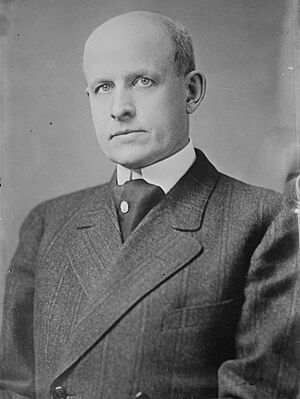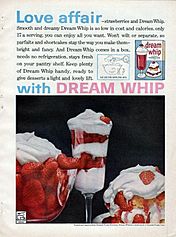General Foods facts for kids
 |
|
| Industry | Food |
|---|---|
| Fate | Merged to Kraft Foods Inc. |
| Predecessor | Postum Cereal Company (1895–1929) |
| Successor | Kraft Foods Inc. (now Mondelez International) Kraft Heinz JDE Peet's (International coffee division) |
| Founded | 1929 |
| Defunct | 1995 |
| Headquarters | Tarrytown, New York, U.S. |
| Products | Breakfast cereals, cereal coffee |
| Brands |
List
|
| Parent | Philip Morris (1985–1990) |
General Foods Corporation was a big food company in the United States. It started from a company called the Postum Cereal Company, which was founded in 1895 by C. W. Post.
The company changed its name to "General Foods" in 1929. This happened after Marjorie Merriweather Post, C. W. Post's daughter, took over the family business and bought several other food companies. Later, in 1985, General Foods was bought by Philip Morris Companies. In 1990, Philip Morris combined General Foods with another large food company, Kraft Foods Inc., to create Kraft Foods. The name "General Foods" was no longer used for the main company after 1995.
The Story of General Foods
How It All Began
The journey of General Foods began with the Post Cereal Company. This company was started by C. W. Post in 1895 in Battle Creek, Michigan. C. W. Post had been a patient at a health center called the Battle Creek Sanitarium. He was inspired by the healthy diet there. This led him to create his own food company. He even became a rival to the Kellogg brothers, who also sold breakfast cereals.
C. W. Post began his business with just $78. He set up his first factory in a barn. His very first product was Postum. This was a "cereal drink" that was an alternative to coffee. It was made from wheat and molasses. Later, in 1897, he created his first cereal, Grape-Nuts. Another cereal, Elijah's Manna, came out in 1904. It was later renamed Post Toasties in 1908.
Becoming General Foods
C. W. Post passed away in 1914. His daughter, Marjorie Merriweather Post, then took charge of the company. The Postum Cereals company grew a lot under her leadership. They bought other well-known brands. For example, they acquired Jell-O (a gelatin dessert) in 1925. They also bought Walter Baker & Company (a chocolate company) in 1927. In 1928, they added Maxwell House coffee to their list of brands.
A very important purchase in 1929 was the frozen-food company owned by Clarence Birdseye. This company was called "General Seafood Corporation." Clarence Birdseye was a very important person in the history of the food industry. He was born in New York City. He became interested in freezing food to preserve it while working as a fur trader. This was in Labrador between 1912 and 1916.
By 1923, Birdseye had found a way to quickly freeze foods using a special belt system. He even got a patent for his invention. In 1924, he started the "General Seafoods Company." They made frozen haddock fillets packed in simple cardboard boxes.
Marjorie Merriweather Post was very excited about the idea of frozen foods. In 1926, she visited Gloucester on her yacht. She was served a meal that had been frozen six months earlier. She was amazed at how fresh it tasted! It took her three years to convince the company's leaders to buy Birdseye's company. After this big purchase, Postum, Inc. officially changed its name to General Foods Corporation.
Soon after buying Birdseye's company, General Foods started testing a wider range of frozen foods. They quickly realized that just having a way to package the food wasn't enough. To sell these products, they needed to keep them frozen in stores. So, Birdseye's engineers started working on a special freezer cabinet. This cabinet was designed just for frozen foods.
The first freezer cabinet appeared in 1934. It needed a lot of space and electricity. Most grocery stores at that time didn't have these things easily available. But for the stores that could use them, it was a great success. Shoppers quickly learned that keeping frozen food at home meant fresher meals. It also meant fewer trips to the market.
In 1932, General Foods also published a cookbook. It was called the General Foods Cook Book. This book was made "To the American homemaker." They published five different versions of this book between 1932 and 1937. The cookbook included pictures and a helpful index.
General Foods was later bought by Altria Group in 1985. In 1989, Altria combined General Foods with Kraft Foods Inc. This new division was called "Kraft General Foods." In 1993, they also bought the cereal brands from Nabisco. Then, in 1995, Kraft General Foods was reorganized. It was simply renamed "Kraft Foods."
Images for kids
-
Magazine ad for the Dream Whip topping in the 1960s






